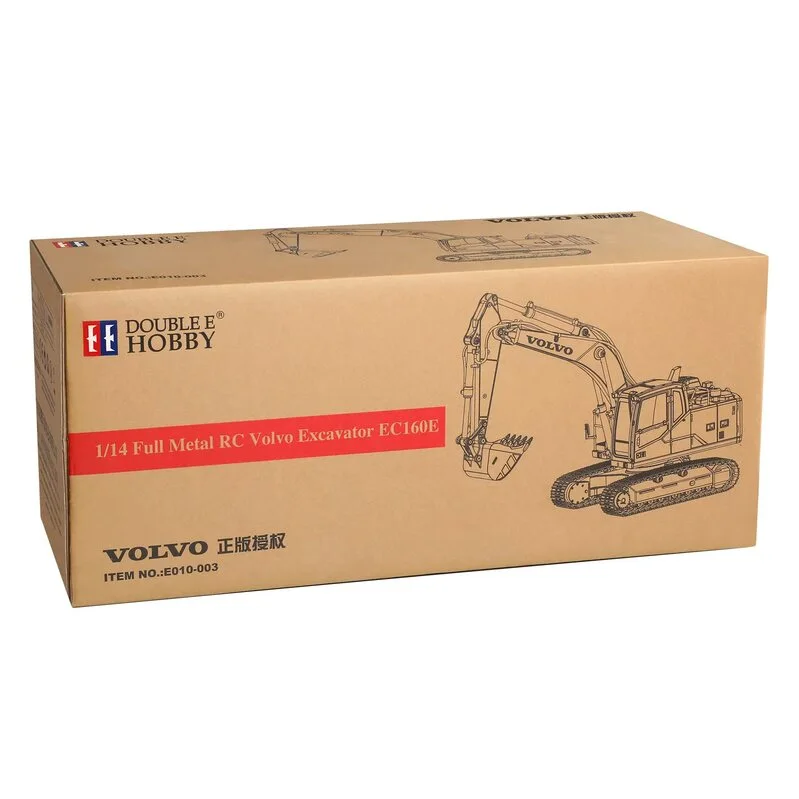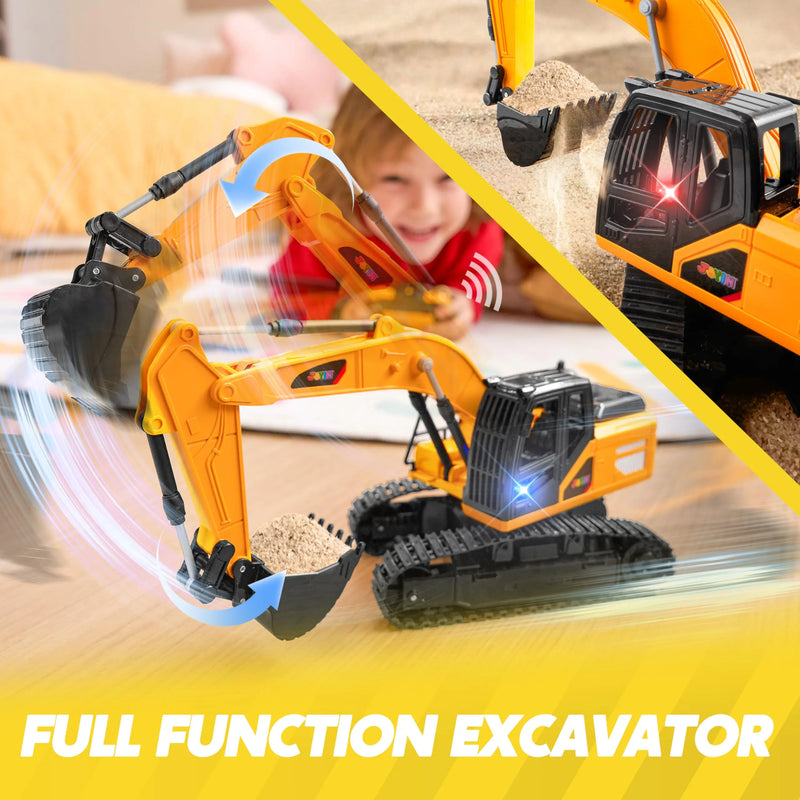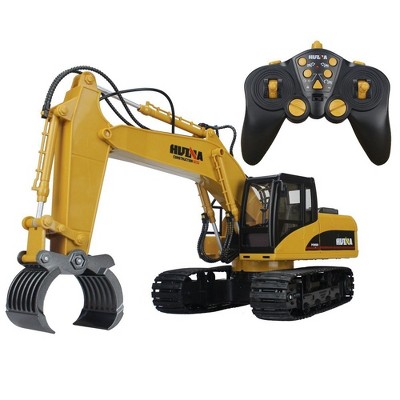Boosting Excavation Productivity with a rc excavator: Best Practices
Wiki Article
The Crucial Functions of Excavator That Make It a Must-Have Tool
Excavators are indispensable in the construction and landscaping industries. Their functional add-ons allow for a variety of jobs, from digging to demolition. Furthermore, they flaunt superior digging deepness and reach, powered by durable engines. Driver convenience and compact layouts boost functionality in various settings. What truly sets excavators apart are their advanced hydraulic systems and durability. Recognizing these attributes can clarify why they are thought about necessary devices on any kind of job site.Functional Attachments for Enhanced Functionality
Excavators are effective equipments on their very own, the enhancement of flexible accessories substantially boosts their performance. These attachments transform a conventional excavator into a multi-purpose device, ideal for a selection of tasks. Containers, for example, can be found in numerous forms and dimensions, allowing operators to dig, scoop, and relocate products successfully. Hydraulic thumbs can be added for improved gripping and handling of large products, such as logs or rocks.Furthermore, specialized accessories like augers and breakers permit for exploration and demolition work, expanding the excavator's energy on construction websites. remote control excavator. Grapples are one more option, perfect for sorting and relocating particles. This adaptability not just raises productivity yet also minimizes the demand for several devices, conserving time and prices. By gearing up excavators with the best accessories, operators can tackle varied tasks, making them indispensable in the construction sectorSuperior Excavating Depth and Get To
Excavators are made with remarkable excavating depth and reach, permitting them to steer in limited rooms and accessibility hard-to-reach areas. This capability is vital for different building and construction and excavation tasks, where traditional machinery may fall short. With adjustable boom arms and extendable tracks, excavators can conveniently navigate irregular surface while maintaining stability.The digging depth can vary considerably among versions, commonly varying from 10 to 25 feet, depending upon the layout and objective. This attribute allows operators to dig deep into foundations, trenches, and other deep frameworks effectively. In addition, the reach of an excavator permits precise excavating and material handling without repositioning the maker frequently, saving time and labor costs.Ultimately, the remarkable digging deepness and reach of excavators make them crucial for professionals looking for to complete complex jobs with accuracy and performance. Their versatility enhances productivity on work websites, showcasing them as an essential tool in modern construction.Powerful Engine Performance

Effective engine efficiency plays an essential function in the abilities of an excavator when it comes to performance and efficiency on building sites. A durable engine creates substantial horse power, permitting the machine to take on sturdy tasks easily - remote control excavator. This toughness converts into faster cycle times, allowing drivers to complete tasks extra quickly.Additionally, powerful engines provide the needed torque to handle tough terrains and differed tons, guaranteeing that the excavator can execute effectively under different problems. Whether it is raising, digging, or moving products, the engine's efficiency straight affects the general operational performance of the machine.Furthermore, innovations in engine modern technology have actually caused boosted gas performance, decreasing functional costs while keeping power outcome. Ultimately, the engine's efficiency serves as the foundation of an excavator, verifying its status as an essential device in the building and construction sector
Advanced Hydraulic Systems

Boosted Lifting Capability
A substantial improvement in raising capability can be credited to advanced hydraulic systems located in contemporary excavators. These systems use high-pressure liquid to create greater pressure, allowing operators to raise much heavier loads effortlessly. The design behind these hydraulics assurances peak efficiency, providing an outstanding power-to-weight proportion that improves overall effectiveness. Consequently, excavators can deal with requiring jobs, such as raising big products or tools, without compromising stability. Furthermore, the robust layout of hydraulic components adds to increased resilience and integrity, making them appropriate for various building and construction atmospheres. This enhanced lifting capability not just minimizes the moment needed for projects yet also decreases the requirement for additional equipment, proving crucial for both productivity and cost-effectiveness in the building and construction industry.Boosted Accuracy Control
Although typical excavators typically fought with accuracy, modern hydraulic systems have transformed control devices, making it possible for drivers to implement jobs with exceptional accuracy. These sophisticated systems make use of proportional control valves that permit smoother and a lot more responsive activities, substantially reducing the margin for error. Operators can currently carefully tune the excavator's motions, making it easier to navigate limited rooms and manage delicate products. Boosted feedback systems even more notify drivers of real-time efficiency, guaranteeing excellent sychronisation between the maker and operator. This increased accuracy not only improves effectiveness but also enhances security on work sites, lessening the threat of mishaps. Therefore, modern excavators geared up with advanced hydraulic systems are invaluable tools for building and excavation projects requiring thorough precision.Operator Comfort and Presence
Driver comfort and visibility are crucial elements in the design of modern excavators (remote control excavator). Functions such as ergonomic seat layout, improved presence choices, and reliable control formats greatly improve the driver's experience and productivity. Focusing on these elements assurances that operators can function properly and securely in numerous conditionsErgonomic Seat Design
Comfort and exposure are vital in excavator layout, with the ergonomic seat playing an essential function in enhancing the operator's experience. An ergonomic seat is engineered to sustain the operator's body, decreasing fatigue during lengthy hours of operation. Adjustable functions, such as seat height, back-rest angle, and back support, accommodate individual preferences and advertise perfect pose. These changes boost comfort and enable the operator to preserve focus on jobs without discomfort. In addition, a properly designed seat can offer much better lateral assistance, enabling for smoother handling when the excavator is in operation. This thoughtful layout not only enhances performance however likewise contributes to general safety and security, guaranteeing that operators can perform their Go Here tasks efficiently and efficiently.Enhanced Exposure Attributes
The layout of an excavator expands beyond simply the seat, with improved presence functions playing a significant role in operator comfort and general safety. Huge home windows and strategically positioned mirrors supply operators with a clear sight of their surroundings, decreasing dead spots. This design consideration allows for far better spatial understanding, which is vital in hectic workplace. On top of that, several excavators include rearview cams and advanced surveillance systems that aid drivers in navigating limited areas. The integration of these visibility includes not just advertises security but also lowers operator tiredness by enabling simpler tracking of job areas. Inevitably, improved exposure adds to a lot more efficient procedures and helps ensure that excavators can execute their tasks successfully and safely.Control Layout Performance
While handling complicated job sites, an efficient control design significantly boosts both operator comfort and presence. A well-designed control configuration guarantees that drivers can access essential functions with very little effort, minimizing fatigue during lengthy hours. Ergonomic joystick positionings and user-friendly button plans permit smooth procedure, allowing drivers to maintain concentrate on the job at hand. In addition, clear presence of both the workplace and the control panel is important for safety and accuracy. Modern excavators often include adjustable seats and control setups to suit different driver choices, even more enhancing convenience. Ultimately, a thoughtfully developed control design not only improves performance but also promotes a much safer working environment by allowing operators to react promptly to altering problems.Compact Style for Urban Environments
As metropolitan construction websites typically encounter area restrictions, a compact layout ends up being crucial for excavators running in these settings. These machines are engineered to browse tight rooms, permitting effective maneuverability in congested task sites. A minimized impact allows them to work closely to existing frameworks, minimizing disruption and making best use of productivity.The compact design usually consists of much shorter tracks and a tighter transforming distance, facilitating procedure in narrow alleys and confined locations. Additionally, light-weight materials add to ease of transportation, making it simpler to move the excavator from one location to another within the urban landscape.Additionally, many portable excavators are geared up with attributes such as functional accessories and extendable arms, boosting their capability while preserving a small dimension. This adaptability allows drivers to take on a selection of jobs, from digging to demolition, all while suitable flawlessly right into the restrictions of urban atmospheres.
Toughness and Upkeep Considerations
Longevity stands as a crucial factor in the efficiency and long life of excavators, particularly sought after city environments. These makers undergo rigorous problems, including differing soil types, extreme temperature levels, and high-frequency usage. Top notch materials and durable building are essential for guaranteeing that excavators can withstand these difficulties without compromising functionality.Regular maintenance is just as crucial in maintaining durability. Scheduled examinations, prompt oil changes, and the replacement of worn parts add substantially to an excavator's lifespan. Operators must additionally take notice of hydraulic systems, tracks, and undercarriages, as these parts typically bear the burden of wear and tear.Investing in resilient excavators with comprehensive upkeep strategies boosts integrity and lessens downtime, eventually bring about raised efficiency on building websites. Therefore, recognizing the interplay between sturdiness and upkeep is essential for any person taking into consideration the acquisition of an excavator for metropolitan projects.Regularly Asked Inquiries
How Do Excavators Compare to Various Other Building Equipment?
Excavators stand out among building tools because of their adaptability, enabling tasks such as grading, lifting, and digging. Compared to others, their hydraulic capacities use higher performance and power, making them essential on numerous task sites.What Safety Features Are Consisted Of in Modern Excavators?
Modern excavators integrate various safety and security features, consisting of rollover defense systems, alarm systems, and advanced imp source exposure improvements. These components work together to reduce risks, making sure driver safety and security while boosting efficiency on construction sites and various other requiring atmospheres.
Can Excavators Be Used in Winter Months Issues?
Excavators can undoubtedly be used in winter months conditions, offered they are equipped with appropriate winter months add-ons and preventative measures are taken. Appropriate upkeep and modifications improve their efficiency, making sure reliable operation regardless of challenging climate conditions.What Is the Typical Life-span of an Excavator?
The average life-span of an excavator typically varies from 7,000 to 10,000 hours of operation. This period can considerably rely on upkeep practices, operating problems, and the certain model's resilience and design features.Just how Do I Choose the Right Excavator Dimension for My Task?
Selecting the right excavator size includes reviewing project extent, website problems, and product kinds. Consider elements like reach, deepness needs, and weight capacity to guarantee maximum performance and safety throughout operation. Dimension matters considerably in project success. Additionally, the reach of an excavator allows for precise excavating and material handling without repositioning the machine often, conserving time and labor costs.Ultimately, the premium excavating depth and reach of excavators make them crucial for specialists looking for to complete intricate tasks with accuracy and effectiveness. Comfort and visibility are extremely important in excavator design, with the ergonomic seat playing a crucial duty in improving the driver's experience. The layout of an excavator extends beyond simply the seat, with improved visibility features playing a considerable function in driver comfort and overall safety and security. Modern excavators frequently integrate adjustable seating and control settings to suit different operator choices, further improving convenience. Lightweight products contribute to relieve of transport, making it easier to relocate the excavator from one area to an additional within the metropolitan landscape.Additionally, check that many portable excavators are geared up with attributes such as versatile add-ons and extendable arms, improving their capability while preserving a small size.Report this wiki page